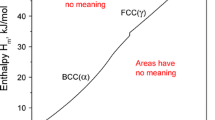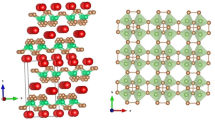Abstract
The alloying effect of the refractory elements Ta and W on the electronic structure of γ-TiAl is investigated by using the first-principles discrete variational method within the framework of density functional theory. The impurity formation energy result indicates that Ta and W can stay steadily in the TiAl system by way of substitution. The Mulliken population, density of states and charge density difference results show that Ta and W both give rise to the strong interaction between themselves and the neighboring host atoms. The alloying effect of the two elements on γ-TiAl is the same.
Similar content being viewed by others
References
Kim Y W. Ordered intermetallic alloys. III: γ-titanium aluminides. JOM, 1994, 46: 30–39
Froes F H, Suryanarayana C, Eliezer D. Review synthesis: Properties and applications of titanium aluminides. J Mater Sci, 1992, 27: 5113–5140
Benedek R, Walle A van de, Gerstl S S A, et al. Partitioning of solutes in multiphase Ti-Al alloys. Phys Rev B, 2005, 71: 094201
Dinko V, Li Z X, Whang S H. Effect of rapid solidification and alloying addition on lattice distortion and atomic ordering in L10 TiAl alloys and their ternary alloys. Metall Trans A, 1988, 19: 2445–2455
Hao Y L, Xu D S, Cui Y Y, et al. The site occupancies of alloying elements in TiAl and Ti3Al alloys. Acta Mater, 1999, 47: 1129–1139
Liu Y, Chen K Y, Zhang J H, et al. Electronic effects of oxygen and vanadium impurities in TiAl. J Phys: Condens Matter, 1997, 9: 9829–9843
Sun F S, Cao C X, Kim S E, et al. Alloying mechanism of beta stabilizers in a TiAl alloy. Metall Mater Trans A, 2001, 32: 1573–1589
Li Y G, Loretto M H. Microstructure and fracture behaviour of Ti-44Al-xM derivatives. Acta Metall Mater, 1994, 42: 2913–2919
Yu R, He L L, Ye H Q. Effect of W on structural stability of TiAl intermetallics and the site preference of W. Phys Rev B, 2002, 65: 184102
Martin P L, Mendiratta M G, Lipsitt H A. Creep deformation of TiAl and TiAl + W alloys. Metall Trans A., 1983, 14: 2170–2174
Triantafillou J, Beddoes J, Zhao L, et al. Creep properties of near γ-TiAl+W with a lamellar microstructure. Scr Metall Mater, 1994, 31: 1387–1392
Ramanujan R V, Maziasz P J, Liu C T. The thermal stability of the microstructure of γ-based titanium aluminides. Acta Mater, 1996, 44: 2611–2642
Zhang Y G, Han Y F, Chen G L, et al. Structural Material of Intermetallics. Beijing: National Defense Industry Press, 2001. 768–779
Ellis D E, Painter G S. Discrete variational method for the energy-band problem with general crystal potentials. Phys Rev B, 1970, 2: 2887–2898
Averill F W, Ellis D E. An efficient numerical multicenter basis set for molecular orbital calculations: Application to FeCl4. J Chem Phys, 1973, 59: 6412–6418
Rosen A, Ellis D E, Adachi H, et al. Calculations of molecular ionization energies using a selfconsistent-charge Hartree-Fock-Slater method. J Chem Phys, 1976, 65: 3629–3634
Delley B, Ellis D E. Efficient and accurate expansion methods for molecules in local density models. J Chem Phys, 1982, 76: 1949–1960
Ellis D E, Benesh G A, Byrom E. Molecular cluster studies of binary alloys: LiAl. Phys Rev B, 1977, 16: 3308–3313
Guo J, Ellis D E, Lam D J. First-principles calculation of the electronic structure of sapphire: Bulk states. Phys Rev B, 1991, 45: 3204–3214
Hohenberg P, Kohn W. Inhomogeneous electron gas. Phys Rev B, 1964, 136: 864–871
Kohn W, Sham L J. Self-consistent equations including exchange and correlation effects. Phys Rev A, 1965, 140: 1133–1138
Wang F H, Wang C Y. First-principles investigation of hydrogen embrittlement in polycrystalline Ni3Al. Phys Rev B, 1998, 57: 289–295
Barth U V, Hedin L. A local exchange-correlation potential for the spin polarized case. J Phys C: Solid State Phys, 1972, 5: 1629–1642
Brandes E A. Smithells’ Metals Reference Book. 6th ed. London: Butterworth, 1983
Hao Y L, Xu D S, Cui Y Y, et al. The site occupancies of alloying elements in TiAl and Ti3Al alloys. Acta Mater, 1999, 47: 1129–1139
Delly B. An all-electron numerical method for solving the local density functional for polyatomic molecules. J Chem Phys, 1990, 92: 508–517
Delly B. Analytic energy derivatives in the numerical local-density-functional approach. J Chem Phys, 1991, 94: 7245–7250
Perdew J P, Burke K, Ernzerhof M. Generalized gradient approximation made simple. Phys Rev Lett, 1996, 77: 3865–3868
Dang H L, Wang C Y, Shu X L. Electronic structure of edge dislocation of core-doped Ti in Fe. Prog Natur Sci, 2004, 14: 477–482
Wang F H, Wang C Y, Yang J L. The effect of zirconium on the electronic structure of grain boundaries in Ni3Al. J Phys: Condens Matter, 1997, 9: 4499–4507
Author information
Authors and Affiliations
Corresponding author
About this article
Cite this article
Dang, H., Wang, C. & Yu, T. First-principles investigation of the alloying effect of Ta and W on γ-TiAl. CHINESE SCI BULL 51, 2690–2695 (2006). https://doi.org/10.1007/s11434-006-2183-0
Received:
Accepted:
Issue Date:
DOI: https://doi.org/10.1007/s11434-006-2183-0




